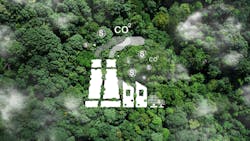Direct Air Capture Reactor Touts Hydrogen Coproduction
Rice University researchers have developed an electrochemical reactor that could significantly reduce energy consumption in direct air capture (DAC) of carbon dioxide. Led by chemical engineer Haotian Wang, the study published in Nature Energy describes a modular, three-chambered reactor with a specialized porous solid electrolyte layer.
Unlike conventional DAC technologies that rely on high-temperature processes, this new reactor uses electrical energy to regenerate carbon dioxide at room temperature. The technology offers several advantages: it works without additional chemicals, generates no unwanted byproducts and can even cogenerate hydrogen, potentially lowering manufacturing costs for net-zero fuels and chemicals.
“Hydrogen coproduction during direct air capture could translate into dramatically lower capital and operation costs for downstream manufacturing of net-zero fuels or chemicals,” said Wang in a news release.
The reactor addresses the limitations of existing carbon capture methods. Traditional approaches like amine-based sorbents are toxic, while water-based solutions require high temperatures to release captured CO2. In contrast, this new system can efficiently split carbonate and bicarbonate solutions, producing alkaline absorbent in one chamber and high-purity carbon dioxide in another.
The researchers optimized electrical inputs to control ion movement and mass transfer, reducing energy barriers. Wang believes this technology represents a significant milestone in atmospheric carbon capture and could motivate industries to pursue more sustainable processes, supporting the transition toward a net-zero future.
About the Author
Traci Purdum
Editor-in-Chief
Traci Purdum, an award-winning business journalist with extensive experience covering manufacturing and management issues, is a graduate of the Kent State University School of Journalism and Mass Communication, Kent, Ohio, and an alumnus of the Wharton Seminar for Business Journalists, Wharton School of Business, University of Pennsylvania, Philadelphia.

